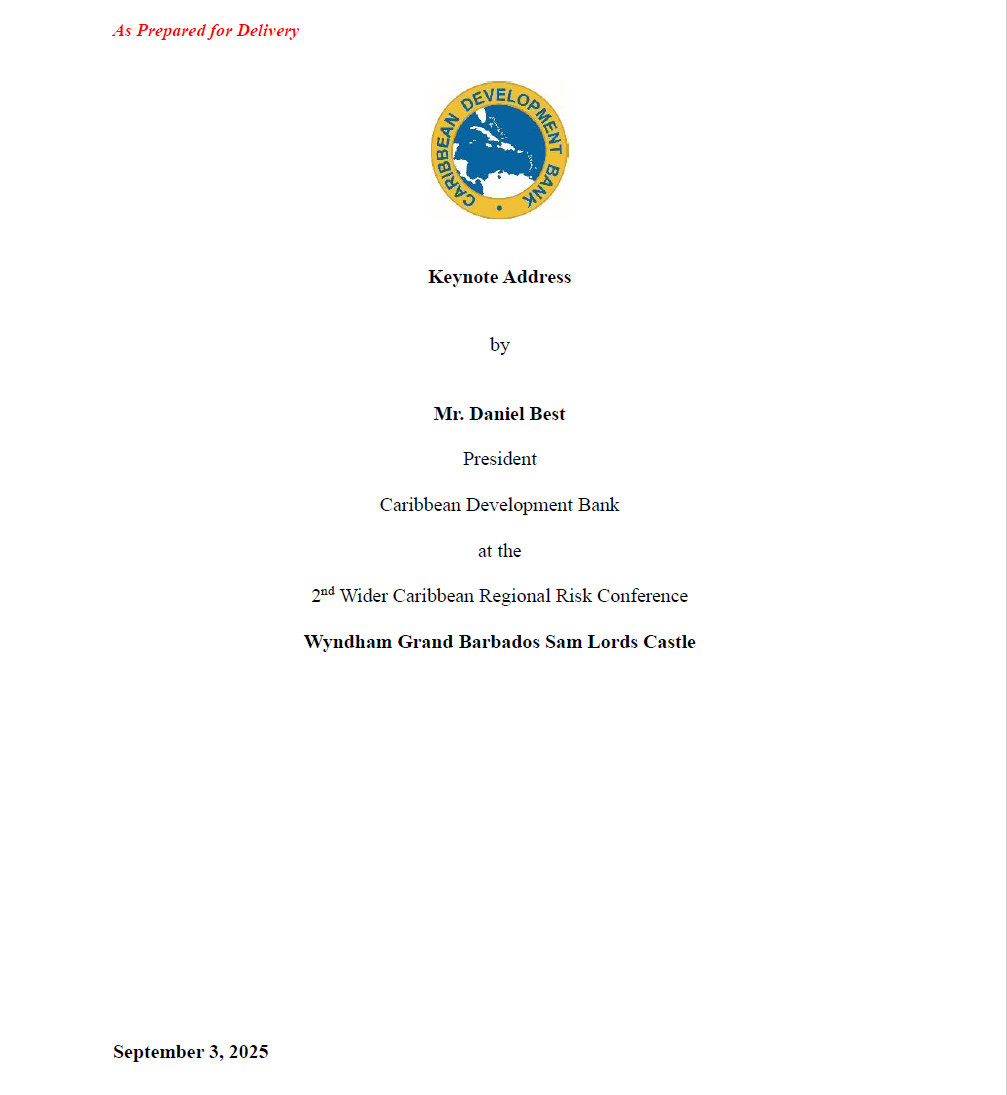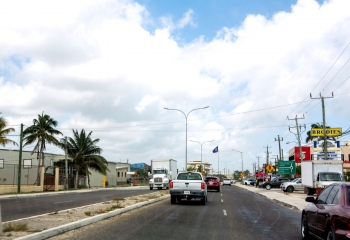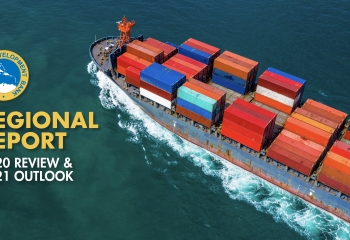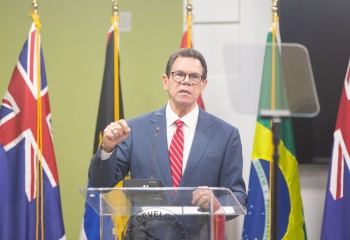The Interconnectedness of Risks

INTRODUCTION
It is an honour to address you today at this pivotal Caribbean Regional Risk Conference, convened at a moment when the global order is being reshaped by forces far beyond our control, but not beyond our collective will to safeguard our region. The 2025 Global Risks Report is sobering. It paints a world grappling with the compounding effects of armed conflict, extreme weather events, misinformation, and cyber vulnerabilities. It is a portrait of a planet in polycrisis.
In this region, our indigenous peoples have been teaching us for centuries that everything is interconnected. These global risks reverberate loudly in the Caribbean. They do not knock at our door one at a time. They arrive together, feed off each other, and strike harder in contexts already stretched by high debt, limited fiscal space, and structural vulnerabilities.
Armed conflicts far from our shores disrupt trade, pushing up food and energy prices. Climate extremes batter our economies, wiping out decades of progress in a single season. A Category 5 hurricane over the Atlantic triggers a fiscal crisis in Roseau. A misinformation campaign online fuels vaccine hesitancy in Port of Spain. Each wave of global instability crashes harder against the shores of our small island and coastal states. For us, these risks converge, they compound, and they cut deep.
Yet even in the face of these cascading risks, our region continues to demonstrate a fierce and unyielding resilience. We saw it vividly just days ago, here in Bridgetown, during the spectacular staging of CARIFESTA. It was a magnificent display of our region’s creativity, resilience and solidarity. I am sure that we can agree that this is the same spirit that carried us from the shadows of plantation economies to the heights of global excellence; that must now guide us through this era of risk. Because my friends, resilience in this region is born from a long history of struggle, creativity and solidarity.
And so, I speak to you through this frame as we gather to reimagine our resilience and rechart our future amid the web of risks that define our time.
THE WEB OF RISKS
Let us begin by acknowledging how, throughout history, our region has so often been caught in a web of risks not of our own making:
We begin with the climate crisis. And given that this Conference is focused squarely on risk in the Caribbean, let us speak plainly.
The planet is heating. Seas are rising. Ecosystems are collapsing. Shifts in rainfall and temperature patterns are reducing crop yields and fish stocks. Extreme weather events are threatening the very hands that feed our region, our farmers and fisherfolk. Coastal erosion and coral bleaching are destroying our natural treasures, the same ones that sustain our tourism, our identity, and our economies.
Perceptions of climate risk alone can deter visitors, cutting off vital foreign exchange and employment. Prolonged droughts are drying up water supplies in countries already classified as water scarce. Rising temperatures are spreading disease. And all of this, while the storms grow stronger, faster, and more unpredictable.
In 2021, the United Nations Secretary-General issued a stark warning: a Code Red for Humanity. And for us here in the Caribbean, we are still living in it every single day. Caribbean countries are seven times more likely to be struck by natural hazards than the global average.
While the world focused on recovery from the pandemic, we were fighting to survive. Since 2020, the Caribbean has been hit by a wave of disasters with damage so severe that in many cases, it exceeded the size of entire national economies. And even before the pandemic, we were still reeling from storms that redefined our vulnerability:
Hurricane Maria, which cost Dominica 225% of GDP.
Hurricane Ivan, which devastated Grenada at 200% of GDP.
But these numbers only tell part of the story. Behind each statistic is a classroom lost. A mother watching her small business washed away. A community forced to start over. These impacts exacerbate poverty, displace families, and tear through the core of our development gains, from agriculture and tourism to public health, education, and fiscal stability.
Friends, climate change sits at the epicenter of the global polycrisis. And with global projections warning of more frequent, more intense, and more rapidly intensifying storms, our people now brace for impact every single season. Our homes, our hospitals, our budgets, our futures are all under siege from a crisis we did not cause. This is a crisis of justice.
Let us now turn to the second risk: economic instability.
Around the world, conflict, supply chain disruptions, inflation, and tightening financial conditions are rattling economies. But in the Caribbean, these shocks strike us where we are most fragile.
We are highly indebted.
We are narrowly diversified.
And we are deeply dependent on external markets and imported goods.
So, when war breaks out thousands of miles away and global energy prices surge, it is our families who pay more to cook their meals and light their homes. When shipping routes are disrupted, it is our small businesses, already operating on thin margins, that struggle to get their products to market. And when global capital flows retreat, our governments are forced to delay the very investments in resilience that could secure our future.
Economic instability is a channel through which global risks are transmitted and amplified, deepening their roots and cascading across our region. Crises that begin elsewhere land swiftly on our shores, turning geopolitical uncertainty into food insecurity, financial market tremors into budget crises, and inflation abroad into pressure at the kitchen table for many of our people.
And this fragility is not standalone. It is intertwined with the climate crisis, which tightens the grip of debt and magnifies every shock. Flooding destroys infrastructure. Hurricanes halt tourism. Droughts reduce output. Each disaster strains fiscal space and makes economic recovery harder.
Friends, this is the trap we must escape. Because without economic resilience, there can be no sustainable development. And without a strong, vibrant, and inclusive economy, we will remain vulnerable to every storm, whether meteorological or financial.
Let us now turn to the third risk: social inequality.
In our region and across the world, inequality is quietly eroding trust in institutions and slowing our progress toward sustainable development.
It is a silent crisis. But its effects are loud, corrosive, and deeply felt. When children are denied access to quality, equitable education, their potential is stifled, and our future workforce is diminished. And when young people, women and men alike, cannot find decent work in our region, frustration grows, talent is wasted, and innovation stalls.
If any individual is excluded from healthcare, the cost is borne by everyone through rising public spending, weaker productivity, and declining community wellbeing. If women, persons with disabilities, indigenous peoples, and marginalised communities are locked out of opportunity, we lose the creativity, dynamism, and diversity that fuel inclusive growth of our region.
Friends, inequality multiplies every other risk we face. It leaves some communities over-exposed and under-protected and deepens vulnerability in the face of climate shocks and economic instability. It limits the reach of our economic growth. And it undermines the very resilience we seek to build.
In fact, the 2025 Global Risks Report warns of a troubling trend, a rise in social fragmentation, mistrust, and growing pessimism about the future. People across the world are losing faith in public institutions and economic systems. And where inequality festers, social cohesion breaks down creating fertile ground for discontent, disengagement, and disillusionment. We cannot afford to lose our people to pessimism. We need the talents and contributions of all our citizens. Our people have always been our greatest asset. A few months ago, at our 55th Annual Board our Governors Meeting, I spoke about our focus on building regional institutions to address these challenges.
An unequal Caribbean cannot withstand the polycrisis of our time. And the danger is the longer inequality persists, the harder it becomes to chart a united course through crisis. If we are serious about sustainable development, then equity must be our compass.
THE COST OF FRAGMENTED RESPONSES
Colleagues, as we confront the growing web of risks threatening our region, we must also confront the urgency for us to do things differently. We cannot afford to respond to interconnected crises with disconnected strategies.
Too often, our development responses are fragmented, designed in isolation, implemented in silos, and misaligned with the complexity of the challenges we face.
INTEGRATES SOLUTIONS FOR SUSTAINABLE DEVELOPMENT
How do we fix it? Through an integrated approach to sustainable development.
First, policy coherence.
We must align climate, economic, and social policies so that they reinforce each other. That means embedding climate resilience into fiscal planning, ensuring that national budgets account for disaster risk and environmental sustainability. It also means designing social protection systems like cash transfers and unemployment insurance that can scale up during climate shocks, so that vulnerable populations are not left behind. These measures allow us to have real impact on the ground, reduce duplication, improve efficiency, and build long-term resilience.
Second, we need to ensure cross-sectoral collaboration.
Effective risk management requires us to break institutional silos. Ministries of finance, education, health, and environment must come together proactively for planning and policy design. Our Development Partners, too, have a critical role to play in facilitating joint programming, pooled funding, and harmonised implementation. We must lead by example and work collaboratively through joint partnerships to support our region.
Third, is data and risk mapping.
Integrated data systems help us visualise how these risks overlap and where vulnerabilities are hidden. In the Caribbean, we need to overlay flood-prone areas with poverty maps, and match climate risk exposure with public infrastructure spending and revolutionise how we target social protection, allocate resources, and build early warning systems. We lack the integrated geospatial data and analytics infrastructure we need to make informed cross-sectoral decisions and that must change. Because what we cannot see, we cannot measure and therefore, we cannot solve.
Fourth, is community engagement.
Our local communities are our greatest source of wisdom, resilience, and innovation. Whether it’s indigenous knowledge about shifting weather patterns or grassroots experience in disaster response, communities across this region are best placed to define solutions that work. So, we must create genuine structures to engage them as partners from the very start. This is how we bank on our own, build trust and strengthen resilience.
Fifth, is innovative financing.
Traditional funding models simply do not meet the scale or complexity of today’s risks.
We must tap into innovative financing sources, and develop more models for blended finance, concessional financing, green bonds, and resilience-linked resources and instruments that crowd in capital and deliver triple-bottom-line returns: economic, social, and environmental. These tools give private investors the confidence to co-finance renewable energy, digital infrastructure, and small business growth. And we must ensure that financing is deployed through a lens of equity and justice.
And finally, regional cooperation.
Crises like climate change, pandemics, and economic shocks do not respect borders. By deepening regional coordination, we can pool resources, share infrastructure, and harmonise policy frameworks across countries. We must continue to invest jointly in disaster preparedness, renewable energy, and social protection systems that are stronger because they are shared.
Friends, the path forward is clear, but it won’t be easy. If we are to navigate the era of polycrisis, then we must quickly abandon fragmentation, and embrace this integrated approach.
THE ROLE OF THE CARIBBEAN DEVELOPMENT BANK
And finally, let me turn to the role of the Caribbean Development Bank, your indigenous Caribbean financing engine. Because as the tide of risks rises, so too do your expectations of us to lead with courage, clarity, and conviction. We are listening. And we will continue to stand shoulder to shoulder with you. We know that responding to a polycrisis requires financing, along with vision, flexibility, and an unwavering commitment to regional resilience.
So, we have a multi-pronged, whole-of-institution approach. One that embraces innovation, strengthens partnerships, and sharpens our strategic alignment with the region’s evolving needs. We are working hand-in-hand with our countries, with regional institutions, and with global partners like CAF, the World Bank, and the Inter-American Development Bank. From joint portfolio reviews to shared implementation arrangements, as we have done in Haiti’s education sector, we are improving delivery, lowering transaction costs, and reducing fragmentation, particularly in fragile and complex settings.
Let me briefly highlight the role we are playing across the three core pillars I have outlined in my address as part of the polycrisis: the climate crisis, economic instability, and social inequality.
CLIMATE CHANGE
Over the next five years, we are committing at least 35% of all approvals to climate adaptation and mitigation. And under our largest ever Special Development Fund, totaling USD 460 million, we are going even further, aiming for 40% climate financing.
To strengthen our pipeline of bankable climate projects, we’ve approved a new Project Preparation Facility, and we’ve secured an expanded GCF accreditation from USD 50 million to USD 250 million, allowing us to support larger, more impactful interventions across the region.
We are also working with the Green Climate Fund to establish a Regional Platform for Catalysing Climate Action, an initiative focused on:
- Accelerating the sustainable energy transition,
- Scaling up climate finance instruments,
- Supporting youth capacity building, and
- Enabling deeper regional connectivity.
We are putting climate resilience at the heart of Caribbean development. And on the global stage, we will not relent in our advocacy and recommendations. We will continue to champion a fundamental reimagining of international financial architecture, one that reflects the realities of our small island economies and the urgency of our development needs.
ECONOMIC INSTABILITY
Colleagues, we know that inclusive economic growth is the bedrock of long-term resilience. So, the CDB’s new Private Sector Development Strategy, approved in 2023, focuses on building a competitive, diversified, and export-oriented ecosystem. Beyond our core investments in infrastructure, education, and utilities, which lay the foundation for productivity, we are now moving decisively to reduce regulatory bottlenecks and unlock access to finance.
Here in Barbados, for example, we are supporting the rollout of an electronic Port Community System, a digital platform that will streamline trade processes, reduce bureaucracy, and improve efficiency for importers and exporters. This is particularly transformative for micro, small, and medium-sized enterprises (MSMEs) who often face prohibitive costs and red tape.
But we’re not stopping there. Through innovative instruments like portfolio guarantees, counter-guarantees, and our soon-to-be-launched Trade Financing Programme, we are partnering with local financial institutions to de-risk lending and expand opportunities particularly in:
- Export-oriented industries,
- Women-led MSMEs, and
- The creative and cultural economy.
In short, we are providing support for Caribbean businesses to compete globally, grow sustainably, and contribute meaningfully to economic resilience.
SOCIAL INEQUALITIES
Friends, at CDB, we are driving data-informed, inclusive development strategies that target the structural inequalities facing women, youth, persons with disabilities, and indigenous communities. Our recent labour market assessments identify the gender gaps, access barriers, and systemic exclusions that hold back participation and opportunity. These insights inform policy reform agendas, from recognising the value of unpaid care work, to bridging skills gaps, to improving access to training and decent work.
And as we address these interconnected risks, we cannot overlook a critical dimension, gender equality, within this web of risks. Women-led MSMEs, are vibrant assets for growth, employment, and innovation but they continue to face systemic barriers in accessing finance. Our recent flagship multi-country Access to Finance Study with the ICR Facility revealed that socio-cultural biases, rigid collateral requirements, and poorly designed loan products are excluding women entrepreneurs from adequate financing. To close this gap, the Bank recently approved the Caribbean Gender Equality Market Sustainability Technical Assistance Project- Caribbean GEMS, in partnership with 2X Global.
Our flagship Basic Needs Trust Fund continues to deliver real results through income transfers, SME support, and grassroots empowerment projects especially for vulnerable communities.
We are also scaling up the Enhanced Country Poverty Assessments (ECPAs), a next-generation poverty analysis tool that goes beyond income to assess:
- Health,
- Education,
- Housing,
- Labour markets, and
- Vulnerability to climate and disaster risks.
By combining GIS mapping, Participatory Poverty Assessments, and macro-socioeconomic diagnostics, the ECPA helps governments target social protection more precisely, reduce exclusion errors, and align policy with the lived realities of their people. This is the kind of integration we need, inclusive data, inclusive policies, inclusive growth.
ENHANCING OUR RISK PROFILE TO SERVE THE REGION
Finally, we know that we cannot call on you to become more resilient unless we are resilient ourselves. At CDB, we are taking bold steps to enhance our risk profile and operational readiness. Through the Exposure Exchange Agreement, we are unlocking new lending headroom, sharing risk with peer institutions and optimising our capital base.
And with the rollout of our Enterprise Risk Management Framework, we are embedding risk management into every corner of our operations, ensuring that risk is strategically governed across the institution.
Colleagues, this is the role of your development bank as a partner in transformation driving a pathway for a future proofed Caribbean.
CLOSING
Our region has just drawn the curtain on CARIFESTA but let the spirit of our artists continue to lead us forward. The late Derek Walcott once wrote: “break a vase, and the love that reassembles the fragments is stronger than that love which took its symmetry for granted when it was whole.” The Caribbean has known fragmentation of geography, of history, of development pathways. But our true strength lies in how we choose to reassemble those fragments: with love, intention, and a shared resolve.
Let this conference be such a moment. A moment of reassembling. Of bold integration. And of Caribbean resolve. In the face of these mounting risks, together, we will build a Caribbean that thrives and leads the world.


